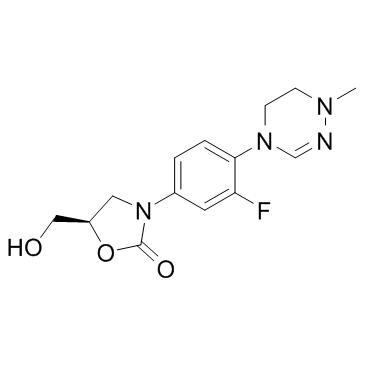1219707-39-7
| Name | delpazolid |
|---|---|
| Synonyms |
2-Oxazolidinone, 3-[4-(5,6-dihydro-1-methyl-1,2,4-triazin-4(1H)-yl)-3-fluorophenyl]-5-(hydroxymethyl)-, (5R)-
delpazolid (5R)-3-[3-Fluoro-4-(1-methyl-5,6-dihydro-1,2,4-triazin-4(1H)-yl)phenyl]-5-(hydroxymethyl)-1,3-oxazolidin-2-one |
| Description | Delpazolid is a novel oxazolidinone antibiotic agent which can inhibit the growth of MSSA and MRSA with a MIC90 of 2 μg/mL for both of them. |
|---|---|
| Related Catalog | |
| Target |
MIC90: 2 μg/mL (MSSA), 2 μg/mL (MRSA)[1] |
| In Vitro | Delpazolid (LCB01-0371), at concentrations of 1×MIC and 2×MIC, has bacteriostatic activity against MSSA and MRSA after 24 h. At concentrations of 4×MIC and 8×MIC, Delpazolid shows bacteriostatic activity, but there is no regrowth at concentrations of 4×MIC and 8×MIC after 24 h of incubation[1]. The survival of M. abscessus is greatly decreased in the presence of Delpazolid (LCB-0371) (MIC50=1.2 μg/mL). Delpazolid dramatically decreases the number of intracellular mycobacteria present at 2 days after infection at concentrations of 0.1, 1, and 10 μg/mL[2]. |
| In Vivo | When administered orally, Delpazolid (LCB01-0371) shows potent protective effects against systemic infections caused by Gram-positive and Gram-negative bacteria. Against infection caused by S. aureus Giorgio (MSSA), the ED50 of Delpazolid is 4.53 mg/kg of body weight. Against S. aureus p125 (MRSA), the ED50 of Delpazolid is 2.96 mg/kg[1]. When Delpazolid (LCB-0371) is administered at 100 mg/kg daily (by gavage), the colony-forming unit (CFU) counts tend to be decreased in the lungs of mice at 7 days after infection[2]. |
| Cell Assay | For the in vitro infection procedure, bone marrow-derived macrophages (BMDMs) are plated at a concentration of 2×105 cells/well and infected for 4 h with M. abscessus. The cells are washed with PBS to remove extracellular bacteria and treated with Delpazolid (LCB-0371) in medium for 2 days. Thereafter, the intracellular bacteria are harvested and the lysates are diluted 10 fold in PBS. Each sample is plated on 7H10 agar plates and incubated at 37°C in a 0.5% CO2 incubator for 7 days[2]. |
| Animal Admin | WT mice are intranasally or intravenously injected with M.Abscessus (1×107 CFU/mouse). After 2 days, the mice are orally administered Delpazolid (LCB-0371) for 4 days, consecutively. At 7 days after M.Abscessus infection, the mice are killed, and their spleens, livers, and lungs are homogenized in PBS. Serial dilutions of the homogenates are plated on 7H10 medium supplemented with 10% OADC (oleic acid, albumin, dextrose, and catalase)[2]. |
| References |
| Density | 1.5±0.1 g/cm3 |
|---|---|
| Boiling Point | 481.8±55.0 °C at 760 mmHg |
| Molecular Formula | C14H17FN4O3 |
| Molecular Weight | 308.308 |
| Flash Point | 245.2±31.5 °C |
| Exact Mass | 308.128479 |
| LogP | -1.05 |
| Vapour Pressure | 0.0±1.3 mmHg at 25°C |
| Index of Refraction | 1.645 |
| Storage condition | 2-8℃ |
